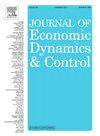市场力量、不平等和金融不稳定性
IF 1.9
3区 经济学
Q2 ECONOMICS
引用次数: 0
摘要
在过去的四十年中,美国经济经历了几个长期趋势:劳动份额下降、利润份额上升、收入和财富不平等扩大、家庭部门杠杆率上升以及相关的金融不稳定性(表现为金融危机概率上升)。本文基于企业在产品和劳动力市场中市场力量的上升,为解释这些趋势提供了一个统一的框架。我们建立了一个一般均衡模型,并证明过去几十年来企业市场力量的上升可以产生所有这些长期趋势。本文章由计算机程序翻译,如有差异,请以英文原文为准。
Market power, inequality, and financial instability
Over the last four decades, the U.S. economy has experienced a few secular trends: declining labor share, increasing profit share, widening income and wealth inequalities, rising household sector leverage and associated financial instability, manifested in an increase in the probability of financial crises. This paper provides a unifying framework for explaining these trends based on a rise in firm market power in both product and labor markets. We develop a general equilibrium model and show that the rise in firm market power over the last few decades can generate all of these secular trends.
求助全文
通过发布文献求助,成功后即可免费获取论文全文。
去求助
来源期刊

Journal of Economic Dynamics & Control
ECONOMICS-
CiteScore
3.10
自引率
10.50%
发文量
199
期刊介绍:
The journal provides an outlet for publication of research concerning all theoretical and empirical aspects of economic dynamics and control as well as the development and use of computational methods in economics and finance. Contributions regarding computational methods may include, but are not restricted to, artificial intelligence, databases, decision support systems, genetic algorithms, modelling languages, neural networks, numerical algorithms for optimization, control and equilibria, parallel computing and qualitative reasoning.
 求助内容:
求助内容: 应助结果提醒方式:
应助结果提醒方式:


